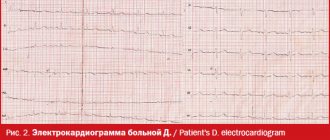Congenital heart defects in the expectant mother
Among congenital heart defects there are three groups:
- Defects with blood discharge from right to left. These include defects of the interatrial and interventricular septum - their non-closure (through the holes, improper discharge of blood occurs), as well as a patent ductus arteriosus *.
- Defects with blood discharge from left to right - transposition (movement) of the main (main) vessels.
- Defects in which there is an obstruction to blood flow (narrowing of large vessels).
*The ductus arteriosus is a short, thin-walled vessel connecting the pulmonary artery and the aorta. Through it, normal blood circulation of the fetus is ensured in the prenatal period - bypassing the lungs, since oxygen enters through the placenta, and normally this duct closes up after birth.
As you know, the heart is a hollow muscular organ responsible for pumping blood in the body. It consists of four departments. These are the right atrium and right ventricle, which make up the right heart, and the left atrium and left ventricle, which make up the left heart. Oxygen-rich blood coming from the lungs enters the left atrium through the pulmonary veins, from there into the left ventricle and then into the aorta. Venous blood enters the right atrium through the superior and inferior vena cava, from there into the right ventricle and further through the pulmonary artery into the lungs, where it is enriched with oxygen and again enters the left atrium.
A heart defect is a persistent pathological change in the structure of the heart that impairs its function. Heart defects can be congenital or acquired. Congenital heart defects are much less common than acquired ones. They arise as a result of disruption of the normal development of the heart and great vessels in fetal development and account for 1-2% of all heart diseases.
The most common defects in pregnant women are the first group. If the disease is accompanied by circulatory failure, i.e. the heart, already working at the limit, can no longer cope with the load, then termination of pregnancy is necessary. Circulatory failure is manifested by fatigue, palpitations, and in more severe cases, shortness of breath and heaviness in the chest. Lack of medical care with the rapid development of heart failure can lead to serious consequences - pulmonary edema (that is, actually turning them off from breathing), thromboembolism (clogging of blood clots) of the pulmonary artery or thrombosis of other large vessels. But usually women with this disease tolerate pregnancy and childbirth well.
Often, after timely surgical correction of a heart defect (if the hole was narrow, it is widened, and vice versa), expectant mothers cope well with the load and the pregnancy ends happily. Recently, more and more women have undergone heart surgery before pregnancy and even during pregnancy.
Defects of the second group are the most severe, and usually the pregnancy has to be terminated, since with these defects circulatory disorders are quite serious and the pregnant woman’s heart often cannot cope with the resulting load.
Obstruction of blood flow in patients of the third group in the absence of circulatory failure usually does not serve as an indication for termination of pregnancy, however, childbirth often ends with a cesarean section, which is associated with a significant increase in the load on the heart during childbirth.
Reasons for the development of congenital heart disease
The causes of congenital heart defects can be genetic abnormalities and the negative impact of external factors. Among the main reasons for the improper formation of the cardiovascular system in the fetus are:
- Chronic diseases of the mother (diabetes mellitus, immune system disorders, hormonal and metabolic pathologies). According to studies, women with diabetes are more likely to have children with congenital heart disease than healthy mothers. The probability of having a child with congenital heart disease in a pregnant woman with rheumatism is 25%.
- A large number of abortions in the past. A history of abortion is a significant risk factor for having a child with congenital heart disease. The more pregnancies that end in abortion, the higher the risk of developing pathology in the fetus.
- Age of both parents. The optimal age for having a child is 20-30 years. Parents over 35 years of age are at risk; before conceiving, they are recommended to undergo comprehensive examination and preparation in order to give birth to a healthy child.
- Exposure to toxic substances, alcohol and nicotine consumption during pregnancy. It has been proven that a number of chemicals, alcohol and nicotine have a teratogenic effect, that is, they lead to the formation of anomalies and malformations of the fetus. Maintaining occupational hygiene and giving up bad habits significantly increases the chances of having a healthy child.
- Lack of vitamins and microelements. A lack of zinc, magnesium, and copper can cause cardiac pathology, so it is extremely important that a pregnant woman’s diet is balanced in microelements, vitamins and proteins. Daily consumption of folic acid and multivitamins before conception and in the first months of pregnancy significantly reduces the risk of having children with congenital heart disease, defects of the brain, spinal cord and other developmental defects.
- Uncontrolled use of medications during pregnancy. Taking amphetamines, anticonvulsants, progestogens and a number of other drugs has a teratogenic effect on the fetal cardiovascular system, so during pregnancy any medications can be taken only as prescribed by a doctor.
- Viral infections of the mother during pregnancy (rubella, influenza, ARVI). Intrauterine infection of the fetus with the rubella virus causes combined pathologies: glaucoma (increased eye pressure), hearing impairment and congenital heart disease. In addition to rubella, chicken pox, herpes, acute respiratory viral infections, sexually transmitted diseases, and toxoplasmosis pose a danger to the fetus.
Note! The development of certain congenital defects depends on gender. Some pathologies are more often diagnosed in boys (coarctation and stenosis of the aorta, transposition of the great vessels), others are predominantly female (atrial septal defect, patent ductus arteriosus). Some congenital heart defects are registered with equal frequency in boys and girls.
Acquired heart defects
Acquired heart defects are associated with inflammation of the endocardium (the inner lining of the heart) and the myocardium - the heart muscle.
These inflammations can occur with rheumatism - a disease of the heart and connective tissue, sepsis - a generalized infectious lesion, atherosclerosis, syphilis. Under the influence of the inflammatory process, scar tissue develops in the valve, which causes deformation and shortening of the valve leaflets or narrowing of the opening. As a result, the valve cannot completely close the hole and valve insufficiency occurs. If the valves are insufficient during systole (contraction of the ventricles), a reverse unnatural flow of blood occurs from the ventricles into the atria. With stenosis (narrowing) of the left atrioventricular orifice during diastole (relaxation of the ventricles), blood does not have time to move from the atrium to the ventricle. Pathological overflow of the left atrium occurs, and the load on it increases. Thus, heart defects lead to poor circulation. Most often (in 75-90% of cases), acquired heart defects develop against the background of rheumatism. (This disease is caused by streptococcus, the same microbe that usually causes tonsillitis and often affects young women.) The predominant lesions of the heart valves are the mitral valve, located between the left atrium and the left ventricle, and the aortic valve, located between the left ventricle of the heart and the aorta. These lesions lead to disruption of the normal functioning of the valves, overload of the heart muscle and circulatory failure.
Often stenosis and insufficiency develop on the same valve (the so-called combined defect). In addition, there are cases when the defects affect two or more valves - this is called combined heart disease.
How will pregnancy proceed if the mother has a heart defect?
The prognosis of pregnancy depends on the degree and combination of damage, as well as on the activity of the rheumatic process (in other words, on whether it is currently exacerbating) and on the severity of circulatory disorders.
The issue of maintaining or terminating a pregnancy is decided collectively by a cardiologist and an obstetrician-gynecologist in each case individually. If pregnancy occurs after heart surgery, you need to consult a cardiac surgeon. You should know that corrective heart surgery does not always lead to the elimination of organic changes in the valve apparatus or the elimination of congenital developmental anomalies. Often, after surgical treatment, there is a relapse of the underlying disease, for example, in the form of restenosis (re-narrowing) after some operations.
It is extremely difficult to decide whether pregnancy is permissible in women with prosthetic heart valves. They are at high risk of developing blood clots, so pregnant women with mechanical valves constantly receive anticoagulant (anti-clotting) therapy.
Of course, the issue of continuing pregnancy in women with cardiovascular diseases is best decided in advance, before its onset. The basis for proper management and treatment of such pregnant women is an accurate diagnosis that takes into account the cause of the disease.
Defects with blood discharge to the right serve as a contraindication to pregnancy, as well as any type of defect with decompensation, in which circulatory failure has already formed.
Look for a doctor!
But if a woman still decides to take a risk and leaves the baby, she needs to immediately actively begin comprehensive treatment. The choice of method of obstetric care is always decided individually. For some diseases, only a cesarean section is possible, in other cases, on the contrary, natural childbirth using epidural anesthesia, obstetric forceps and other devices that help “turn off” the most dangerous second and third periods (pushing and birth of the placenta) from childbirth is preferable.
Article on the topic
Less is more. How to take medications during pregnancy
Listing all the diseases with which you can and cannot give birth is long and pointless, because not only the disease itself matters, but also its phase, course and how the body adapts to the disease. Therefore, the most important thing is to find a cardiologist whom you can trust 100%.
Features of pregnancy management with heart defects
Pregnancy management in women with heart defects, as mentioned above, is carried out with the participation of several specialists. It requires not only the coordinated activities of specialists at the antenatal clinic, but also the disciplined behavior of the woman herself: early registration with the antenatal clinic, timely visits to doctors and tests, a full examination, and timely comprehensive treatment.
If possible, then, of course, it is better to entrust your health to a large medical center specializing in this problem. This could be a department for women with cardiovascular pathology at an institute or a specialized department at a large maternity hospital, where competent specialists with experience in managing patients with such pathology can effectively help.
The course of pregnancy in women with heart defects has its own characteristics. Often there are complications such as gestosis (complications of pregnancy, manifested by the appearance of edema, protein in the urine, increased blood pressure), which are characterized by a latent course and are difficult to treat. Pregnancy in such patients is often complicated by the threat of termination - the number of spontaneous abortions and premature births significantly exceeds the average. In addition, the course of pregnancy can be complicated by impaired uteroplacental blood flow, which leads to hypoxia (oxygen starvation) or intrauterine growth retardation. The risk of placental abruption is also high. The accumulation of blood clots in the placenta leads to the exclusion of part of the placenta from the bloodstream and increased oxygen starvation of the fetus.
For all the above reasons, women with heart defects and other pathologies of the cardiovascular system must be hospitalized at least three times during pregnancy:
The first hospitalization is at the 8-10th week of pregnancy to clarify the diagnosis and decide on the possibility of continuing the pregnancy. The issue of termination of pregnancy before 12 weeks is decided depending on the severity of the defect, the functional state of the circulatory system and the degree of activity of the rheumatic process.
The second hospitalization is at the 28-29th week of pregnancy to monitor the state of the cardiovascular system and, if necessary, to maintain heart function during the period of maximum physiological stress. This is due to the fact that it is during this period that the load on the heart normally increases significantly (one of the periods of maximum physiological stress) - the so-called cardiac output increases by almost a third, mainly due to an increase in heart rate.
The third hospitalization is at the 37-38th week to prepare for childbirth and choose a method of delivery, drawing up a birth plan.
If signs of circulatory failure, exacerbation of rheumatism, the occurrence of atrial fibrillation (frequent irregular heartbeat), gestosis or severe anemia (decreased hemoglobin) and other complications occur, hospitalization is necessary, regardless of the stage of pregnancy.
The issue of termination of pregnancy at a later stage is quite complex. Doctors often have to decide what is less dangerous for the patient: to terminate the pregnancy or allow it to develop further. In any case, if signs of circulatory failure or any concomitant diseases appear, the patient should be hospitalized, subjected to a thorough examination and treatment.
If the situation does not require such drastic measures, the pregnant woman should exercise maximum caution. First of all, you need to take care of sufficient rest and long, 10-12-hour sleep. A 1-2 hour nap during the day is beneficial. Quite effective means of treatment and prevention are physical therapy, morning exercises, and walks in the fresh air. The set of morning exercises should be the simplest, not leading to excessive strain or fatigue.
The diet must be made as varied and nutritious as possible, with a high content of protein products (up to 1.5 g/kg body weight). You need to take multivitamins. In addition, the doctor may prescribe sessions of hyperbaric oxygenation (sessions in a pressure chamber where air with a high oxygen content is supplied under pressure), general ultraviolet irradiation.
Recommendations for congenital heart disease
Children and adults with congenital heart defects should be under constant supervision of a cardiologist, both before and after surgery to correct the pathology. Parents of children with congenital heart disease must master the skills of first aid and cardiopulmonary resuscitation in order, if necessary, to help the child before the ambulance arrives.
Patients with congenital heart disease have weak immunity, so to prevent infections it is necessary to observe the rules of personal hygiene, organize a balanced diet and moderate physical activity. Exercising helps strengthen the cardiovascular system and avoid obesity. Doctors recommend swimming, cycling, moderate jogging and tennis for patients with congenital heart disease.
After surgery to correct congenital heart disease, patients must strictly follow all the doctor’s advice, adhere to dietary and lifestyle recommendations, and take prescribed medications to reduce the risk of postoperative complications.
Management of childbirth with heart disease
The issue of medical tactics during childbirth is of particular importance. The best choice is early hospitalization at 36-37 weeks of pregnancy. The delivery plan is drawn up in consultation with the participation of an obstetrician, cardiologist or therapist and anesthesiologist. The choice of method is strictly individual for each patient, depending on the situation.
Modern medicine has a sufficient arsenal of diagnostic tools to promptly prevent pregnancy complications in women with heart defects. The following methods are usually used:
- Electrocardiography is the recording of electrical phenomena occurring in the heart muscle when it is excited. This study allows you to register changes in the heart muscle by changes in electrical impulses.
- Phonocardiography is a method of recording sounds (tones and noises) resulting from the activity of the heart. It is used to assess heart function and recognize abnormalities, including valve defects.
- Echocardiography (ultrasound of the heart). It is used to study blood circulation and cardiodynamics (heart function), determine the size and volume of the cavities of the heart, and assess the functional state of the heart muscle. The method is harmless to the mother and fetus.
- Load testing is used to assess the functional state of the heart muscle. Load tests on a bicycle ergometer are also used when examining pregnant women - during this test, an ECG is taken for the patient at different intensities of physical activity.
- The study of the function of external respiration and the acid-base state of the blood involves studying lung capacity and blood oxygen saturation at rest and during exercise. The study allows you to determine how adequate the blood oxygen saturation is, i.e. How well the heart can cope with the load at the moment.
- Blood tests are usually a standard test that is performed when examining all pregnant women. However, in this case, the doctor pays special attention to the state of the blood coagulation system.
- Fetal ultrasound, cardiotocography , which are regularly performed after 28 weeks to assess the condition of the placenta and fetus. These studies help determine whether the fetus is suffering from a lack of oxygen and nutrients. In addition, fetal ultrasound allows you to identify possible malformations of the child even before birth and take appropriate measures - from urgent surgery after delivery to termination of pregnancy.
The advantage remains with the natural method of delivery. In case of compensated heart disease, therapy is carried out aimed at preventing heart failure and supporting the heart, preventing pulmonary edema, and, if arrhythmia is possible, ECG monitoring. Adequate labor pain relief is provided, as fear and pain lead to additional stress on the heart.
Advertising
As a rule, the most difficult period of labor - pushing (the period of expulsion of the fetus) - is tried to be shortened with the help of an episiotomy - incision of the perineum. Switching off pushing (application of obstetric forceps) is carried out in case of circulatory problems.
Many doctors believe that full-term delivery by cesarean section reduces the burden on the cardiovascular system and reduces mortality among pregnant women with heart defects.
Caesarean section for heart defects is performed in the following cases:
- with an active rheumatic process (fever, pain in the relevant organs, characteristic changes in tests);
- with severe heart disease with severe left ventricular failure and no effect of drug therapy;
- when a heart defect is combined with obstetric pathology requiring surgical delivery.
Successful delivery of patients suffering from severe congenital and acquired heart defects can be facilitated by delivery under conditions of hyperbaric oxygenation.
After the birth of the fetus and the passage of the placenta, there is a rush of blood to the internal organs (and primarily to the abdominal organs) and a decrease in blood circulation in the vessels of the brain and the vessels feeding the heart muscle. Therefore, to prevent deterioration of the condition, immediately after the birth of the child, the woman is given medications to ensure normal heart function.
Symptoms and signs of congenital heart disease
Symptoms of the disease largely depend on the type of defect, but there are general signs characteristic of most heart pathologies:
- Pale or cyanotic skin. In children with blue heart defects, cyanosis (blueness) of the skin and mucous membranes is noted, which intensifies when the child sucks and cries. With white heart defects, the skin becomes pale, the child freezes even in a warm room.;
- Weakness and fatigue. Children with congenital heart disease are often restless, refuse to breastfeed, and quickly get tired during feeding. As they grow older, they begin to lag behind their peers in physical development, get tired even with small loads, and, as a rule, have an asthenic physique;
- Dizziness and fainting. Due to progressive circulatory failure, patients with congenital heart disease often experience dizziness, and with strong emotional or physical stress they may faint;
- Headache. With congenital heart defects, the blood supply to the brain is disrupted, so patients often complain of headaches caused by spasm and vascular thrombosis;
- High or low blood pressure. Changes in blood pressure with congenital heart disease are associated with hemodynamic disturbances. For example, with coarctation of the aorta, even in a newborn, blood pressure can reach 200 mmHg. (at a norm of 50 mmHg);
- Edema. Edema with congenital heart disease appears with the development of heart failure at the end of the compensation stage - the beginning of decompensation, when the heart ceases to cope with high load;
- Dyspnea. The time at which shortness of breath appears depends on the type of congenital heart defect. With severe combined defects, the symptom may appear immediately after the birth of the child. In mild forms of anomalies, shortness of breath appears in the stage of compensation during physical activity, in the stage of decompensation - at rest;
- Pain in the heart, a feeling of heaviness in the chest. With mild defects without pronounced hemodynamic disturbances, a feeling of heaviness and pain in the heart appears during physical exertion and emotional stress. With severe congenital heart disease, discomfort in the heart area bothers patients even at rest;
- Extrasystole (heart rhythm disturbance). Heart rhythm disturbances are a common symptom of congenital heart disease, which is often combined with tachycardia (rapid heartbeat). The cause of extrasystoles in heart defects is cardiac conduction disturbances, hypoxia (lack of oxygen) of the ventricles and atria.
When listening to the heart, characteristic murmurs are revealed. Children with congenital heart disease, as a rule, have an asthenic (thin) build, often suffer from respiratory infections, and they often have poor appetite and depressed mood.
Postpartum period in women with heart defects
The risk of thrombosis, bleeding and heart failure persists up to 5 days after birth, so during this period the woman is prescribed bed rest. From the 7-11th day, if the defect is of a rheumatic nature, the woman is prescribed a study to determine the activity of rheumatism; The activity of rheumatism is monitored during the year after childbirth.
Postpartum women with heart disease can be discharged from the maternity hospital no earlier than 2 weeks after birth in satisfactory condition under the supervision of a cardiologist at the place of residence.
If decompensation does not occur after childbirth and medications are not required, breastfeeding is preferable.
After the birth of a child, specialists must examine him for the presence of heart defects, since in children whose mothers had such problems, the risk of having them increases many times over.
Thus, timely diagnosis and proper treatment allow many women who were previously unable to have a child to experience this joy. And experts are always ready to help them with this.
Steep route
According to accepted standards, the expectant mother should undergo a second ultrasound screening at 16–20 weeks of pregnancy. From this time on, it is already possible to identify congenital heart defects and other developmental defects in the fetus. If something happens, completing this important study will help develop the optimal route for the treatment of a tiny patient.
If any suspicions arise, the pregnant woman will be sent to a specialized hospital, where there is not only precision equipment, but also highly qualified doctors. A council of specialists will decide what to do next: whether to recommend that the woman terminate the pregnancy (after all, part of the congenital heart disease, unfortunately, is incompatible with life or is accompanied by severe mental retardation) or wait for childbirth and plan an operation (emergency or delayed) for the baby.
Those defects that could not be detected at the second screening are most often detected at the third (at 30–32 weeks). By the way, the method of delivery is also chosen by specialists.
Article on the topic
Heart disease is not a death sentence. How children with cardiac pathologies are now saved








